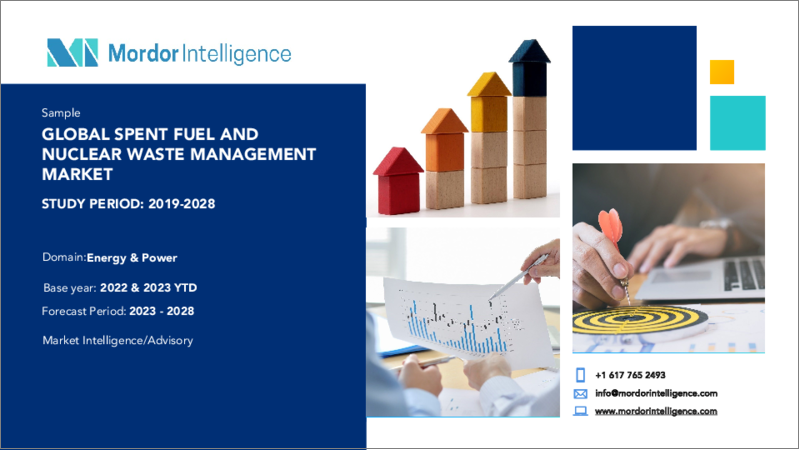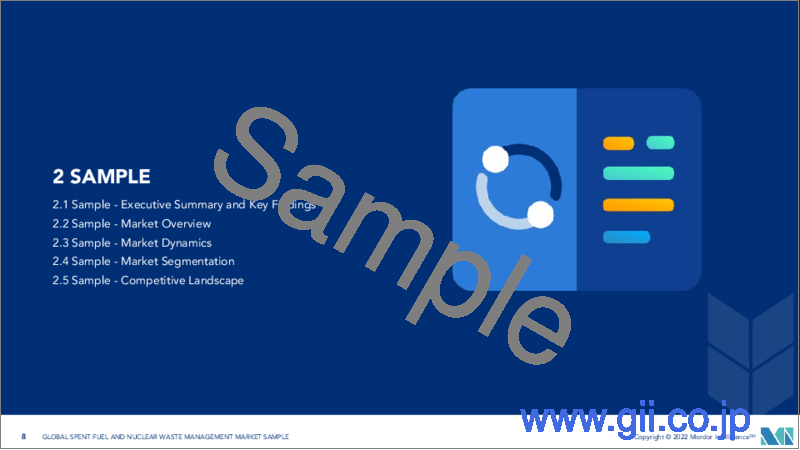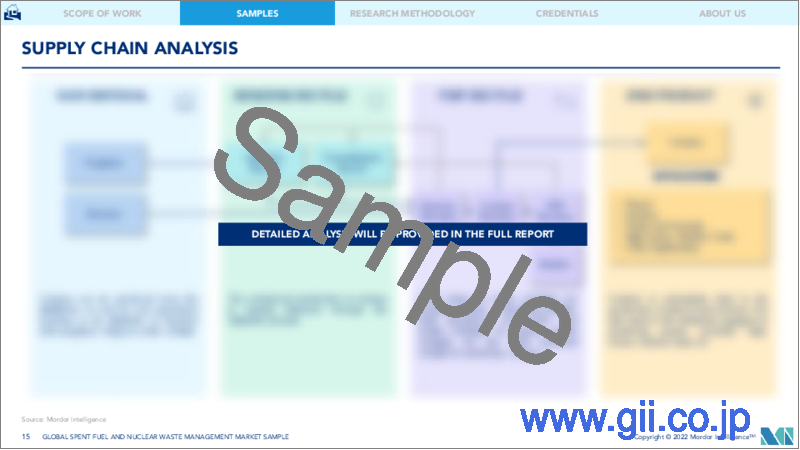|
|
市場調査レポート
商品コード
1198462
使用済燃料および放射性廃棄物管理市場- 成長、動向、予測(2023年-2028年)Spent Fuel and Nuclear Waste Management Market - Growth, Trends, and Forecasts (2023 - 2028) |
||||||
|
● お客様のご希望に応じて、既存データの加工や未掲載情報(例:国別セグメント)の追加などの対応が可能です。 詳細はお問い合わせください。 |
|||||||
| 使用済燃料および放射性廃棄物管理市場- 成長、動向、予測(2023年-2028年) |
|
出版日: 2023年01月23日
発行: Mordor Intelligence
ページ情報: 英文 125 Pages
納期: 2~3営業日
|
- 全表示
- 概要
- 目次
使用済燃料および放射性廃棄物管理市場は、予測期間である2022-2027年に1.5%のCAGRで推移すると予想されています。
COVID-19のパンデミックの間、市場は大きな悪影響を示しませんでした。原子力発電所は、化石燃料と比較して、より低い炭素排出量で電気を生成する能力を持っています。原子力発電で発生する廃棄物の量は、他の火力発電技術に比べて非常に少ないのですが、原子力発電所の運営者にとって、核廃棄物を適切かつ安全に管理することは最も重要な課題となっています。二酸化炭素排出量の目標を達成するために、よりクリーンなエネルギー源の採用が進んでいることや、政府の政策支援による原子力発電所の延命化などの要因が、市場を牽引すると予想されます。しかし、高い初期費用と投資回収期間が、予測期間中の使用済燃料および放射性廃棄物管理市場の妨げになる可能性があります。
主なハイライト
- 低レベル廃棄物分野は過去に市場を独占し、予測期間中も市場を独占する可能性が高いです。
- 中東・アフリカの主要国は、少数の大手企業を伴って、非化石燃料ベースの発電技術、特に小型原子炉に投資しています。サウジアラビアは、2030年までに原子力プログラムの現地調達率を30~50%にすることを計画しています。同様に、ヨルダンや他の数カ国も原子力発電所建設の初期段階にあり、今後、世界の使用済み燃料と核廃棄物管理市場の成長の機会を提供すると思われます。
- アジア太平洋地域は、中国やインドなどの主要新興国の存在により、使用済み燃料と核廃棄物管理の世界市場において著しい成長を遂げることが期待されています。
使用済燃料および放射性廃棄物管理市場の動向
低レベル放射性廃棄物が市場を独占する見込み
- 放射性核廃棄物には、本質的に放射性である物質や放射能に汚染され、今後使用されることがないと判断された物質が含まれます。核燃料サイクルから発生する低レベル廃棄物(LLW)は、アルファ放射能で1トンあたり4ギガベクレル(GBq/t)、ベータガンマ放射能で12GBq/tを超えない放射性物質を含んでいます。LLWは体積を減らすため、多くの場合、廃棄前に圧縮または焼却されます。
- LLWは、取り扱いや輸送時に遮蔽する必要がなく、地表近くの施設での処分に適しています。
- 調査した市場はLLWが大部分を占めており、これは全放射性廃棄物のうち、体積の90%を占めるが放射能は1%に過ぎないです。LLWの処分のための管理方法(採用または検討中)は、近地層処分、中間深度の洞窟への処分、深地層への処分といった3つの主要な選択肢を包含しています。
- 核廃棄物の90%以上がLLWに分類されるため、放射性廃棄物を適切かつ安全に保管するためのインフラ整備が必要です。さらに、クリーンで持続可能なエネルギー源として原子力発電が普及していることから、さまざまな国が原子力発電所や関連施設に投資しており、これが使用済み燃料と核廃棄物管理市場の推進力になると予想されています。
- したがって、長い耐久性と原子力発電という有望な発電の代替手段が、世界的に原子力発電所の需要を途方もなく高めているのです。
- さらに、アジア太平洋地域では、原子力発電の利点と信頼性により、さまざまな発電所が建設中です。このような背景から、使用済燃料および放射性廃棄物市場の需要も高まっています。
- このため、予測期間中は低レベル放射性廃棄物分野が市場を独占すると予想されます。
アジア太平洋地域が大幅な成長を遂げる見込み
- アジア太平洋地域は、予測期間中に最も急成長する市場となる見込みです。北米や欧州とは対照的に、発電能力、特に原子力発電の増加は長年にわたって制限されてきました。アジアのいくつかの国では、増大するクリーンな電力需要を満たすために、新しい原子炉の計画や建設が進められています。中国、日本、韓国、インドが、予測期間中にアジア太平洋地域の使用済み燃料・核廃棄物管理市場を牽引すると予想される主要国です。
- 中国は、原子力発電の開発に最先端の技術と最も厳しい基準を用いており、原子力施設の立地、設計、建設、運転、廃棄物管理までのライフサイクル全体を厳格に管理しています。2022年2月現在、中国には稼働中の原子炉が54基、建設中の原子炉が14基、さらに建設開始間近の原子炉があります。2021年の稼働中の原子炉の合計容量は50.71Gweで、同年の発電量は約375TWhとなり、同国の総発電量の4.9%を占めました。
- 同国は今後数年間、原子炉群を拡大する予定です。2020年6月現在、中国には合計1224万kWeの原子炉があり、50万kWe以上が建設中および計画段階です。2020年4月、生態環境部原子力安全検査局の局長は、未完成の15基の原子炉はすべて建設を再開し、すでに稼働している原子炉はCOVID-19の発生による影響を受けなかったと述べた。
- 中国の原子力部門は今後も堅調に拡大し、2018年から2027年にかけて年平均10.3%能力が増加し、次の10年の終わりには95GW以上の原子力設備容量になると予想されています。これは、ベースロード発電を脱炭素化し、原子力の専門知識を蓄積して輸出するという中国の野心的な目標に沿うものです。したがって、廃棄物の量は既存の原子力発電所からの廃棄物よりもかなり多くなると予想され、これが予測期間中の市場を牽引する可能性があります。
- さらに、世界原子力協会によると、同国のウラン需要は2020年に11,000 TU以上(原子炉58基稼働)、2025年に約18,500 TU(原子炉100基)、2030年に約24,000 TU(原子炉130基)と予測されています。中国が原子炉の新設数を急速に増やしていく中で、燃料の再処理と使用済み燃料の貯蔵に関する長期的な政策が実施される見込みであり、調査した市場に弾みをつけています。
- インドの2021年末の原子力設備容量は688.5万kWで、建設中の純容量は約420万kWでした。インドは、急増する電力需要への対応、低炭素電源の採用による排出量の削減、ウランとトリウムの埋蔵量を活用する手段として、国内の原子力分野の拡大に大きな関心を示しています。
- このため、アジア太平洋地域は、予測期間中に使用済燃料および放射性廃棄物管理市場で大きな成長を遂げると予想されます。
使用済燃料および放射性廃棄物管理市場の競合他社分析
使用済燃料および放射性廃棄物管理市場は、技術が複雑なため、この業界で事業を行う企業が少ないため、適度に統合されています。この市場の主要なプレーヤーは、Fluor Corporation、Bechtel Group Inc.、Westinghouse Electric Company LLC、Perma-Fix Environmental Services Inc.、Veolia Environnement SA .などです。
その他の特典
- エクセル形式の市場予測(ME)シート
- アナリストによる3ヶ月間のサポート
目次
第1章 イントロダクション
- 調査対象範囲
- 市場の定義
- 調査の前提
第2章 エグゼクティブサマリー
第3章 調査手法
第4章 市場の概要
- イントロダクション
- 2027年までの市場規模・需要予測(単位:億米ドル)
- 最近の動向と展開
- 政府の規制と政策
- 市場力学
- 促進要因
- 抑制要因
- ポーターのファイブフォース分析
- 供給企業の交渉力
- 消費者の交渉力
- 新規参入業者の脅威
- 代替品の脅威
- 競争企業間の敵対関係
第5章 市場セグメンテーション
- タイプ
- 低レベル廃棄物
- 中レベル廃棄物
- 高レベル廃棄物
- 発生源
- 核燃料サイクル
- 原子力発電用原子炉
- 放射性物質採掘・粉砕・抽出活動
- 研究、医療、および産業用ソース
- 軍事・防衛計画
- その他のソース
- 核燃料サイクル
- 地域別
- 北米
- 欧州
- アジア太平洋地域
- 南米
- 中東・アフリカ
第6章 競合情勢
- M&A、ジョイントベンチャー、コラボレーション、合意書
- 主要なプレーヤーが採用する戦略
- 企業プロファイル
- Fluor Corporation
- Westinghouse Electric Company LLC(Toshiba)
- Bechtel Group Inc.
- Augean PLC
- Perma-Fix Environmental Services Inc.
- Agence Nationale pour la gestion des dechets radioactifs(ANDRA)
- Veolia Environment SA
- Studsvik AB
- Enercon Services Inc.
- EnergySolutions Inc.
第7章 市場機会と将来動向
The spent fuel and nuclear waste management market is expected to record a CAGR of 1.5% during the forecast period, 2022-2027. During the COVID-19 pandemic, the market did not witness any major negative impact. The nuclear power plant has the ability to generate electricity with lower carbon emissions as compared to fossil fuels. Although the amount of waste generated by nuclear power is very small relative to other thermal electricity generation technologies, proper and safe management of nuclear waste is of utmost importance for the nuclear power plant operators. Factors such as increasing adoption of cleaner energy sources to meet carbon emission targets and nuclear plant life extensions due to supporting government policies are expected to drive the market. However, the high initial cost and a high payback period are likely to hinder the spent fuel and nuclear waste management market during the forecast period.
Key Highlights
- The low-level waste segment dominated the market in the past and is likely to dominate the market during the forecast period.
- Major countries in Middle East & Africa, accompanied by a few major companies, are investing in non-fossil fuel-based power generation technologies, especially in small nuclear reactors. Saudi Arabia plans to achieve 30-50% of local content for its nuclear program before 2030. Similarly, Jordan and a few more countries are in the initial phase of nuclear power plant construction, which is likely to provide an opportunity to grow the global spent fuel and nuclear waste management market in the coming future.
- Asia-Pacific is expected to witness significant growth in the global spent fuel and nuclear waste management market, owing to the presence of several major developing nations such as China and India.
Spent Fuel & Nuclear Waste Management Market Trends
Low-level Waste Expected to Dominate the Market
- Radioactive nuclear waste includes any material that is intrinsically radioactive or contaminated by radioactivity and deemed to have no further use. Low-level waste (LLW) generated from the nuclear fuel cycle has a radioactive content not exceeding 4 giga-becquerels per ton (GBq/t) of the alpha activity or 12 GBq/t beta-gamma activity. To reduce its volume, LLW is often compacted or incinerated before disposal.
- It does not require shielding during handling and transport, and it is suitable for disposal in near-surface facilities.
- The market studied is dominated by LLW, which comprises 90% of the volume but only 1% of the radioactivity of all radioactive waste. Management practices for the disposal of LLW (adopted or under consideration) encompass three main options, such as near-surface disposal, disposal in caverns at intermediate depth, and disposal in deep geological formations.
- As more than 90% of nuclear waste comes under the LLW category, more infrastructure is needed to store the radioactive waste properly and safely. Moreover, as nuclear power is getting popular due to clean and sustainable sources of energy, various countries are investing in nuclear power plants and related facilities, which is expected to drive the spent fuel and nuclear waste management market.
- Therefore, the long durability and a promising alternative for power generation in the form of nuclear-based power generation have been tremendously inflicting the demand for nuclear power plants globally.
- Furthermore, various power plants are under construction across the Asia-Pacific region, owing to the advantage and reliability offered by nuclear-based power generation. This, in turn, is driving the demand for the spent fuel and nuclear waste market.
- Therefore, owing to the above points, the low-level waste segment is expected to dominate the market during the forecast period.
Asia-Pacific Expected to Witness Significant Growth
- Asia-Pacific is expected to be the fastest-growing market during the forecast period. In contrast to North America and Europe, where growth in electricity generating capacity, particularly nuclear power, has been limited for many years. Several countries in Asia are planning and building new nuclear power reactors to meet their increasing demand for clean electricity. China, Japan, South Korea, and India are the major countries that are expected to drive the spent fuel and nuclear waste management market in Asia-Pacific during the forecast period.
- China uses the most advanced technology and the most stringent standards for the development of nuclear power, and it strictly manages the entire life cycle of nuclear facilities from siting, design, construction, and operation, to waste management. As of February 2022, China has 54 nuclear power reactors in operation, 14 under construction, and more about to start construction. The combined capacity of operating nuclear power reactors in 2021 was 50.71 Gwe, which generated around 375 TWh of electricity in the same year, representing 4.9% of the total electricity generation in the country.
- The country plans to expand its nuclear reactors fleet in the coming years. As of June 2020, China had around 12 reactors with a combined capacity of 12.24 GWe and more than 50 GWe under construction and planned phases. In April 2020, the director of the Nuclear Safety Inspection Department at the Ministry of Ecology and Environment stated that all the 15 unfinished reactor units had resumed construction, and reactors that were already in operation were not affected due to the COVID-19 outbreak.
- The Chinese nuclear sector is expected to continue to expand at robust rates, with capacity increasing by an annual average of 10.3% between 2018 and 2027, resulting in more than 95GW of installed nuclear capacity by the end of the next decade. This is in line with the ambitious aims of China to decarbonize its baseload generation and amass nuclear expertise to export. Hence, the volumes of waste are expected to be significantly greater than the existing waste from nuclear power plants, which may drive the market during the forecast period.
- Furthermore, according to the World Nuclear Association, the demand for uranium in the country is expected to be over 11,000 TU (with 58 reactors operating) in 2020, about 18,500 TU (for 100 reactors) in 2025, and about 24,000 TU (for 130 reactors) in 2030. As China rapidly increases the number of new reactors, a long-term policy is expected to be in place for fuel reprocessing and spent fuel storage, providing an impetus to the market studied.
- India had 6.885 GW of installed nuclear capacity at the end of 2021 and around 4.2 GW of net capacity under construction. India has shown significant interest in expanding its domestic nuclear sector as a means to meet the rapidly growing demand for electricity, lower emissions through the adoption of low-carbon power sources, and capitalize on its indigenous reserves of uranium and thorium.
- Therefore, owing to the above points, Asia-Pacific is expected to witness significant growth in the spent fuel and nuclear waste management market during the forecast period.
Spent Fuel & Nuclear Waste Management Market Competitor Analysis
The spent fuel and nuclear waste management market is moderately consolidated due to few companies operating in the industry because of the complex technology. The key players in this market include Fluor Corporation, Bechtel Group Inc., Westinghouse Electric Company LLC, Perma-Fix Environmental Services Inc., and Veolia Environnement SA.
Additional Benefits:
- The market estimate (ME) sheet in Excel format
- 3 months of analyst support
TABLE OF CONTENTS
1 INTRODUCTION
- 1.1 Scope of the Study
- 1.2 Market Definition
- 1.3 Study Assumptions
2 EXECUTIVE SUMMARY
3 RESEARCH METHODOLOGY
4 MARKET OVERVIEW
- 4.1 Introduction
- 4.2 Market Size and Demand Forecast, in USD billion,until 2027
- 4.3 Recent Trends and Developments
- 4.4 Government Policies and Regulations
- 4.5 Market Dynamics
- 4.5.1 Drivers
- 4.5.2 Restraints
- 4.6 Porter's Five Forces Analysis
- 4.6.1 Bargaining Power of Suppliers
- 4.6.2 Bargaining Power of Consumers
- 4.6.3 Threat of New Entrants
- 4.6.4 Threat of Substitutes Products and Services
- 4.6.5 Intensity of Competitive Rivalry
5 MARKET SEGMENTATION
- 5.1 Type
- 5.1.1 Low-level Waste
- 5.1.2 Intermediate-level Waste
- 5.1.3 High-level Waste
- 5.2 Source
- 5.2.1 Nuclear Fuel Cycle
- 5.2.1.1 Nuclear Power Reactors
- 5.2.1.2 Radioactive Mining, Milling, and Extracting Activities
- 5.2.2 Research, Medical, and Industrial Source
- 5.2.3 Military and Defense Programs
- 5.2.4 Other Sources
- 5.2.1 Nuclear Fuel Cycle
- 5.3 Geography
- 5.3.1 North America
- 5.3.2 Europe
- 5.3.3 Asia-Pacific
- 5.3.4 South America
- 5.3.5 Middle East & Africa
6 COMPETITIVE LANDSCAPE
- 6.1 Mergers and Acquisitions, Joint Ventures, Collaborations, and Agreements
- 6.2 Strategies Adopted by Leading Players
- 6.3 Company Profiles
- 6.3.1 Fluor Corporation
- 6.3.2 Westinghouse Electric Company LLC (Toshiba)
- 6.3.3 Bechtel Group Inc.
- 6.3.4 Augean PLC
- 6.3.5 Perma-Fix Environmental Services Inc.
- 6.3.6 Agence Nationale pour la gestion des dechets radioactifs (ANDRA)
- 6.3.7 Veolia Environment SA
- 6.3.8 Studsvik AB
- 6.3.9 Enercon Services Inc.
- 6.3.10 EnergySolutions Inc.




